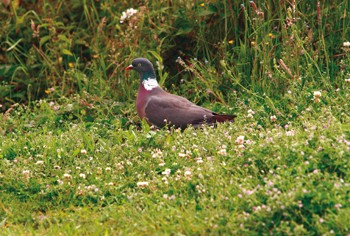Time for a recce

Experienced shooters will agree that reconnaissance is an important element of pigeon shooting. If possible, it should be carried out the day before shooting. The first task is to scout over the farm or estate where you have permission to shoot. Weather forecasts should be checked to ensure that the shoot day will be suitable, otherwise it will be a waste of time and fuel. Look for woodies on the crops where you expect them to be and decide which crop to cover, if there?s a choice. This depends on the size of the flock and whether or not they return once displaced. It?s a big mistake to settle on the first fl ock you see containing, say, 50 birds, when with a little more effort you may find 500 or more tucking into a field of peas just down the road.
Avoid the midday sun
The experienced Shot will know when to carry out the first day?s reconnaissance depending on the time of the year. For example, during the hottest days in summer, the pigeon will feed early in the day before retiring to the woodland for shade and to digest their meal. They then return in the late afternoon to refuel before heading off to roost. So, the time for reconnaissance will be either early or late. I no longer favour early starts ? I reserve them for the odd morning wildfowl flight. A visit under the hot sun at midday will usually result in finding the field devoid of birds, and thus an inexperienced Gun will miss the opportunity of an excellent day?s shooting. Some of my biggest bags in the summer months have been achieved in the afternoons, between 2.30pm and 7pm.
At most other times of the year, it?s not as important, as the pigeon will come and go at any hour of the day. In winter, watch for pigeon sitting in trees surrounding oilseed rape. It?s a good bet that they will be feeding there, and probably a good many feed close to those trees. Whatever you do, don?t be tempted to shoot at the pigeon if they lift while you are doing your reconnaissance. This will serve only to spook them, and cause them to stay away, possibly not even returning the next day.
Be aware of your surroundings
If you are on newly acquired shooting land, there are many potential problems to consider. Safety must be foremost in your mind on your first visit. You must consider where the footpaths, farm buildings and houses are; and whether there are grazing horses or public rights of way.
Make sure that your hide is more than 50ft from any public highway, and consider the issue of noise pollution. I also ask the farmer whether anyone (for example, a friend or neighbour) has permission to walk their dogs off the footpaths ? this is often the case, even where there are game shoots.
I always drive around the headland of every new field to assess potential problems. At the same time, I look for suitable hide locations, as this will save a great deal of time the following day.
On the shoot day, I carefully consider where to locate the hide, taking into consideration flightlines and wind direction ? bear in mind that the wind may have changed overnight, altering flightlines and feeding locations.
The perfect spot for sport
As I know the areas I shoot over quite well, I often know exactly where the best spots are for placing my hide. Frequently, I can take my vehicle all the way there. There are several important points to consider while setting up. I use a spinning seat, so I need a flat and stable surface so that it won?t tip when I swing to fire. I strongly recommend a seat with a backrest ? the days of sitting on an uncomfortable oil drum, kit box or even a camping chair are long gone. For one thing, the latter is too low if you intend to stand for some or all of your shots.
It is especially important, if you have a fixed seat, to face it in the direction that you intend to shoot. So, for example, if the pigeon are decoying from the right, the seat should be angled towards the left, and vice versa if the birds are coming from the left. I always set the pattern downwind of the hide so that the killing area is about 15 paces to one side. This allows me to take shots as the pigeon pass the hide rather than when they pitch in directly in front of me.
Any other birds?
Finally, it?s always a good idea to ask the farmer what you should do if ? after 1 September ? a flock of Canada geese flies over your hide. I mention this date, as I?m not in favour of shooting Canadas before the goslings are mature enough to fend for themselves. As far as I?m concerned, we should respect our quarry whatever the law says, as there?s no excuse to do otherwise. Asking the question could well earn you permission to shoot them, and if you are lucky enough to gain permission, don?t forget to have the correct ammunition to hand.








